Assessment of Physico-chemical Parameters of Well Water of Kalmeshwar Town, Nagpur Maharashtra (India)
Dilip L. Budhlani1 * and P.B. Nagarnaik1
1
Dean Academy,
G. H. Raisoni College of Engineering,
Nagpur,
India
DOI: http://dx.doi.org/10.12944/CWE.6.1.15
Physico-chemical analysis of Well Water of Kalmeshwar Tehsil, District Nagpur has been studied, All the samples were analysed to assess the water quality parameters like Temperature, Physical appearance, Odor, Turbidity, pH, Chloride, Nitrates, Total hardness, Permanent hardness, Total Dissolved Solids, Sodium, Potassium, Sulphate, Iron, Fluoride, Total alkanity, Dissolved Oxygen, B.O.D, C.O.D. It was found that most of the parameters are within the permissible limit as described by W.H.O. (1978) except Total Hardness and Total Dissolved solids found to be 510 to 1640 mg/L, 930 to 2800 mg/L. respectively.
Copy the following to cite this article:
Budhlani D.L, Nagarnaik P.B. Assessment of Physico-chemical Parameters of Well Water of Kalmeshwar Town, Nagpur Maharashtra ( India ). Curr World Environ 2011:6(1);109-114 DOI:http://dx.doi.org/10.12944/CWE.6.1.15
Copy the following to cite this URL:
Budhlani D.L, Nagarnaik P.B. Assessment of Physico-chemical Parameters of Well Water of Kalmeshwar Town, Nagpur Maharashtra ( India ). Curr World Environ 2011:6(1);109-114. Available from: http://www.cwejournal.org/?p=1293
Download article (pdf) Citation Manager Publish History
Select type of program for download
| Endnote EndNote format (Mac & Win) | |
| Reference Manager Ris format (Win only) | |
| Procite Ris format (Win only) | |
| Medlars Format | |
| RefWorks Format RefWorks format (Mac & Win) | |
| BibTex Format BibTex format (Mac & Win) |
Article Publishing History
| Received: | 2011-05-10 |
|---|---|
| Accepted: | 2011-06-16 |
Introduction
Water is second to oxygen as being essential for life. People can survive days, weeks, or even longer without food, but only about few days without water. Water is one of the essential commodities of everyday life and is placed in position just after air. Although it is nature’s abundant gift but most of it is present in oceans (97%) and in the icebergs in the Polar Regions (2%) which are of no use for utilization and the remaining (1%) of all earth’s water, which is available in lake, rivers and underground for utilization. Again this available water found in nature is never H2O alone. Hence it can be considered as a separate entity and can be expressed as (H2O +X), where ‘X’ is measurable and controlled. More over this available water is also contaminating day by day by different human activities. These pollutions are mainly due to rise standard of living, urbanization, expansion of agriculture and increase of population.
The population of India has exceeded thousand million today and also the urban population more than four million, which indicate the large demand of water for domestic purposes. The ill health in the developing and under-developing countries is mainly due to lack of safe drinking water.
Drinking water is never pure. Water naturally contains minerals and microorganisms from the rocks, soil and air with which it comes in contact. Human activities can add many more substances to water. But drinking water does not need to be pure to be safe. In fact, some dissolved minerals in water can be beneficial to health. For example, the National Research Council (National Academy of Sciences) states that drinking water containing dissolved calcium and magnesium generally contributes a small amount toward calcium and magnesium human dietary needs. Fluoride, either naturally occurring or added to the water supply, can help protect against tooth decay. Whether the drinking water is safe or not will depend on impurities which are present and its amount.1
A survey conducted by WHO in 1975 on community water supplies revealed the fact that in India while 80% of the population in urban areas had access to community water supplies and only 18% of the rural population had reasonable access to safe water.
The present paper deals with the drinking water quality analysis of some wells of kalmeshwar town, Nagpur (India). The results are compared with W.H.O. and I.S.I Standard.
Material and Methods
Kalmeshwar is a Tehsil place in district Nagpur (Maharashtra).The Kalmeshwar Town is surrounded by industrial area. The sampling point of Wells of the same areas Ward No. 1 near Mahadev mandir (W1), Ward No. 2 near Barmase house (W2), Ward No. 5 near Shri Tulsiramji Shade house (W5), Ward No.10 near Shri Shirbhate sabagruha (W10), Ward No.13 near Gawhane Layout (W13A), Ward No.13 near Hore Layout (W13B) Ward No. 14 near Shri Mahendra Shende house (W14). The methods applied for analysis are usually followed as prescribed by NEERI (1986)2
Pre-sterilized bottle were used for the collection of D.O and B.O.D samples. Temperature, pH of the samples was measured in the sampling station. The water samples have preserved to determine D.O, B.O.D the test of the samples were analyzed in laboratory.
Results and Discussion
pH range of 6.5 to 8.5 is normally accepted as per guide line suggested by W.H.O (1984)(3). From the Fig.1,it is found that the pH value of water sample in the study area ranged from 7.4 to 8.2 which shows that the water sample was observed to be slightly alkaline.
It is known that pH of water does not cause any sevior health hazard. The desirable limit of Total Alkalinity is 200mg/l. The value of Alkalinity of Well Water varied from 270 to 315 mg/l as shown in Fig.2.
The desirable limit of total hardness of drinking water according to Indian standard institute (ISI 10500)(4) is 300mg/L, in surveyed area its value in ground water varied from 510 to 1640mg/L. From the Fig.3 it is found that permanent hardness in ground water sample varied from 140 to 1390 mg/ L.
Sodium and Potassium are termed as alkali metals, sodium is abundant in water because of its compound are readily soluble in ground water, it is generally found to be >5mg/l. Ground water pollution by sodium salt is an unavoidable phenomenon cause from the return flow of irrigation and disposal of Industrial and Urban waste. In large concentration it may affect a person with a Cardiac deficiency. From the Fig.4 it is found that, the values of Sodium in surveyed area varied from 140 to 230 mg/L
Chloride in form of Chloride Ions is one of the major inorganic anions in water and waste water. The salty taste produced by chloride concentration is variable and dependent on the chemical composition of water. Water containing chloride 250mg/l has detectable salty taste. From Fig.5 it is found that the values of chloride in ground water sample were varied from 270 to 410 mg/L.
The chloride is troublesome in irrigation water and harmful for aquatic life. The concentration of Nitrate (as an NO3) for supplied water over 100mg/l causes mathenoglobinemia particular infant up to six month of age, whose main liquid intake is powdered milk formula made up with tap water containing high concentration of nitrates. Nitrates form nitrosamines in stomach, which cause gastric cancer. From Fig.6 it is observed that, the entire sample tested nitrate was within the limit for general use.
Limit of turbidity is 5 to 10 NTU. From the Fig.7 it was found that, the turbidity value of surveyed area is within the limit.
As per IS 10500 the permissible Presence of Sulphate has less effect on taste of water as compare to presence of chloride.4 High value of Sulphate above 500mg/l produces bitter taste to water and exerts adverse effect on human. In the entire sample tested sulphate was within the limit for general use.
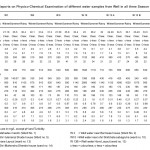 |
Table 1: Reports on Physico-Chemical Examination of different water samples from Well in all three Season (2010-11) Click here to View table |
Total Solids are considered to be the sum of dissolved and suspended solids. In water sources the dissolved solid which usually predominate, consist mainly of inorganic salts, small amount of organic matter and dissolved gases. The suspended solid contents much of organic matter any increase there of rends to increase the degrees of pollution of water, if used for public health purpose. The upper limit 500ppm has been set in order to control undesirable taste and diarrhea. The permissible limit of TDS suitable for drinking is 500mg/l (W.H.O).2 The Total Dissolved Solid values of water sample in study area ranged from 930 to 2800 mg/l.
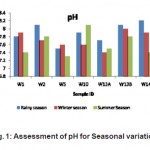 |
Figure 1: Assessment of pH for Seasonal variation Click here to View figure |
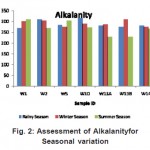 |
Figure 2: Assessment of Alkalanity for Seasonal variation Click here to View figure |
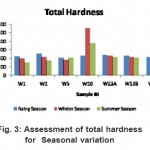 |
Figure 3: Assessment of total hardness for Seasonal variation Click here to View figure |
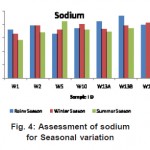 |
Figure 4: Assessment of sodium for Seasonal variation Click here to View figure |
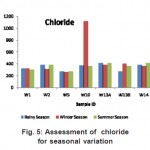 |
Figure 5: Assessment of chloride for seasonal variation Click here to View figure |
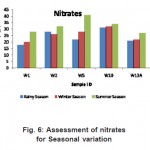 |
Figure 6: Assessment of nitrates for Seasonal variation Click here to View figure |
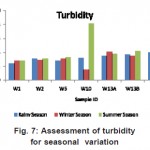 |
Figure 7: Assessment of turbidity for seasonal variation Click here to View figure |
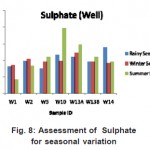 |
Figure 8: Assessment of Sulphate for seasonal variation Click here to View figure |
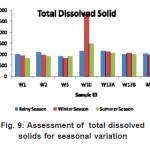 |
Figure 9: Assessment of total dissolved solids for seasonal variation Click here to View figure |
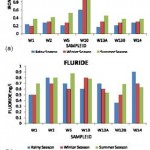 |
Figure 10: Assessment of iron and fluoride for Seasonal variation Click here to View figure |
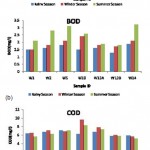 |
Figure 11: Assessment of DO, BOD, and COD for Seasonal variation Click here to View figure |
The permissible limit of iron in water is 0.3 to 1mg/l, the iron content in studied area is within the limit except Well water of ward no.10 (W10). The permissible limit of fluoride content in water is 1 to 1.5mg/l at different sampling station it were observed within the limit, as shown in Fig.10 (a) and (b).
As shown in Fig.11 a, b, and c. DO, BOD, and COD values ranged from 4.8 to 7.6 mg/L, 1.8 to 3.1mg/L & 5.7 to 9.6mg/L of deferred sampling station. BOD is the amount of DO required to stabilize the biodegradable organic matter by micro organism of water under aerobic conditions. Higher BOD values attribute to the stagnation of water body leading to the absence of self purification cycle. Increases of COD values are due to the pollution of input zones.
Conclusion
Qualitatively the water in the studied area is not potable, hard & slightly mineralized. It is suitable for domestic and irrigational use.
References
- APHA, standard methods for examination of water and waste water, 14th edition American public health association, Washington, D.C. (1975).
- NEERI, Manual on water and waste water analysis, national environment engg. Research institute, Nagpur: 3402 (1986).
- WHO, guideline for drinking water quality Genewa (1984).
- ISI Indian standard specification for drinking water ISI 10500, (1964).
- Kataria, H. C. et al., Physico- Chemical analysis of Bore Well of Bairagarth area of Bhopal city, Orient. J. Chem. 22(1): 175-176 (2006).
- S.k. shrivastava¹* V.K. gupta,² kiran vajpai,³ D.K. Shrivastava and Sharad k. Vajpai*Study of physicochemical quality of pond water in Bilaspur, Chhattisgarh 3(1): 97-107
- Renu nayar* and Deepak Tiwari,Studies on the physico-chemical characteristics of ground water of Korba 3(1): 175-180
- Ananad sharma¹ and Dr. Tiwari. Monitoring of ground water quality in Mandideep industrial area, Bhopal (India) 3(1): 199-202.







